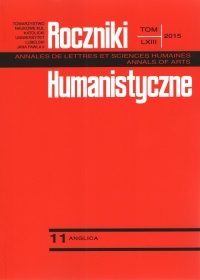Demonstrative or article? The case of ten in Polish
Abstract
The paper discusses the syntactic status of the Polish demonstrative pronoun ten ‘this’ in the light of grammaticalization theory. The discussion begins with establishing formal (morphosyntactic) as well as semantic criteria for discriminating between articles and demonstratives. Then it reviews arguments for the demonstrative status of ten put forward in the literature. The paper ends with providing evidence for the definite article status of ten. Although the primary function of ten is still that of a demonstrative pronoun, it reveals some traces of categorial change on the grammaticalization cline in spoken Polish.
References
Abney, Steven. 1987. The English noun phrase in its sentential aspect. PhD dissertation. MIT.
Allen, Cynthia. 2006. “Possessives and determiners in Old English.” In Types of Variation: Diachronic, Dialectal and Typological Interfaces. Terttu Nevalainen, Juhani Klemola and Mikko Laitinen (eds.), 149–170. Amsterdam: John Benjamins.
Bacz, Barbara. 1991. “On some article-like uses of the demonstrative ten [this] in Polish. Could ten become an article?” Langues et Linguistique 17,1–16.
Bańko, Mirosław, Rafał L. Górski, Barbara Lewandowska-Tomaszczyk, Marek Łaziński, Piotr Pęzik, and Adam Przepiórkowski. 2012. Narodowy Korpus Języka Polskiego. [National Corpus of the Polish Langauge] Warszawa: IPI PAN.
Bartnik, Artur. 2014. “Determiners and possessives in Old English and Polish.” In Advances in the syntax of DPs. Anna Bondaruk, Gréte Dalmi and Alexander Grosu (eds.), 247–266. Amsterdam/Philadelphia: Benjamins.
Bošković, Željko. 2008. “What will you have, DP or NP?” Available at: http://web.uconn.edu/boskovic/papers/nels.illinois.proceedings.final.pdf.
Cinque, Guglielmo. 2002. Functional Structure in DP and IP. The Cartography of Syntactic Structures. Vol.1. New York: Oxford University Press.
Czardybon, Adrian. 2013. “Definiteness and concept types in Polish.” A paper presented at Languages with and without articles 2013 Workshop, Université Paris 8, France.
Giusti, Giuliana. 2001. “The birth of a functional category: from Latin ILLE to the Romance article and personal pronoun.” In Current Studies in Italian Syntax: Essays Offered to Lorenzo Renzi. Guglielmo Cinque and Giampaolo Salvi (eds.), 157–171. Amsterdam: North Holland.
Greenberg, Joseph H. 1978. “How does a language acquire gender markers?” In Universals of Human Language. III. Joseph H. Greenberg, Charles A. Ferguson and Edith Moravcsik (eds.), 47–82. Stanford: Stanford University Press.
Heusler, Andreas. 1962. Altislandisches Elementarbuch. Heidelberg: Carl Winter [Germanische Bibliothek 1].
Himmelmann, Nikolaus. 2001. “Articles.” In Language Typology and Language Universals. Martin Haspelmath, Ekkehard König, Wulf Oesterreicher, and Wolfgang Raible (eds.), 831-841. Berlin: de Gruyter.
Himmelmann, Nikolaus. 1997. Deiktikon, Artikel, Nominalphrase: zur Emergenz syntaktischer Struktur. Tübingen: Niemeyer.
Klemensiewicz, Zenon. 1953. Zarys składni polskiej [An outline of Polish syntax]. Warszawa: PWN.
Kryk, Barbara. 1987. On Deixis in English and Polish: the role of demonstrative pronouns. Frankfurt am Main: Varlag Peter Lang.
Lehmann, Christian. 2002. Thoughts on Grammaticalization. Erfurt: Seminar für Sprachwissenschaft der Universität.
Lyons, Christopher. 1999. Definiteness. Cambridge: Cambridge University Press.
Meillet, Antoine. 1912. “L’évolution des formes grammaticales.” Scientia 12/26. Reprinted (1951): Linguistique historique et linguistique générale, 159–174. Paris: Champion.
Mendoza, Imke. 2005. “Polish demonstrative pronouns as ‘markers of value’.” Glossos 6: 1–20.
Miodunka, Władysław. 1974. “Funkcje zaimków w grupach nominalnych współczesnej polszczyzny mówionej [The functions of pronouns in nominal phrases in contemporary spoken Polish].” Kraków: Zeszyty Naukowe UJ 43.
Nagórko, Alicja. 2007. Zarys gramatyki polskiej [An outline of Polish grammar]. Warszawa: PWN.
Pisarkowa, Krystyna. 1968. “Zaimek w polskim zdaniu. 2. Obserwacje przydawki zaimkowej [The pronoun in the Polish sentence. 2. Observations of the pronominal attribute].” Język Polski 48: 12–33.
Scatton, Ernest A. 1984. A reference grammar of Modern Bulgarian. Columbus, Ohio: Slavica.
Skrzypek, Dominika. 2010. “Between a demonstrative and an article. The status of -in in Old Swedish.” Folia Scandinavica 11: 145–162.
Studler, Rebekka. 2013. “The morphology, syntax and semantics of definite determiners in Swiss German.” In Crosslinguistic Studies on Noun Phrase Structure and Reference (Syntax and Semantics). Patricia Cabredo Hofherr and Anne Zribi-Hertz (eds.), 143–171. Brill: The Netherlands.
Swan, Oskar E. 2002. A grammar of contemporary Polish. Bloomington: Slavica.
Szwedek, Aleksander. 1976. Word order, sentence stress and reference in English and Polish. Linguistic Research: Edmonton, Canada.
Topolińska, Zuzanna. 1984. “Składnia grupy imiennej [The syntax of the noun phrase].” In Gramatyka współczesnego języka polskiego. Składnia [The grammar of contemporary Polish. Syntax]. Zuzanna Topolińska (ed.), 301–389. Warszawa: PWN.
Traugott, Elisabeth Closs and Graeme Trousdale. 2010. “Gradience, gradualness and grammaticalization. How do they intersect?” In Gradience, gradualness and grammaticalization. Elisabeth Closs Traugott and Graeme Trousdale (eds.), 19–44. Amsterdam: John Benjamins.
Willim, Ewa. 2000. “On the grammar of Polish nominals.” In Step by Step: Essays on Minimalist Syntax in Honor of Howard Lasnik. Roger Martin, David Michaels, and Juan Uriagereka (eds.), 319–346. Cambridge, Mass.: MIT Press.
Wolter, Lynsey. 2006. That’s That: The Semantics and Pragmatics of Demonstrative Noun Phrases. PhD dissertation University of California Santa Cruz.
Copyright (c) 2015 Roczniki Humanistyczne

This work is licensed under a Creative Commons Attribution-NonCommercial-NoDerivatives 4.0 International License.





